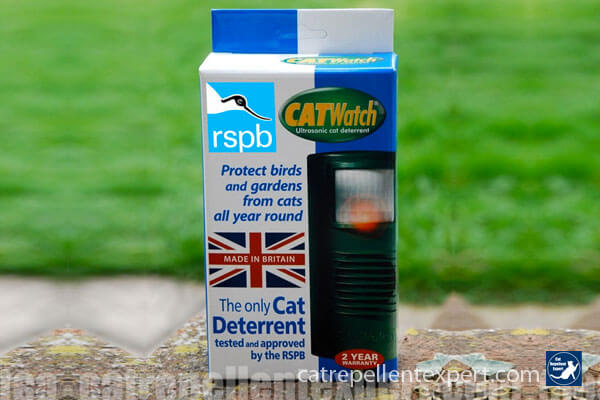The Top 10 cat deterrents for your garden UK
Welcome to Cat Repellent Expert! If you’re looking for an effective method of keeping cats out of your garden, then you’re in the right place.
Many people are driven mad by their neighbours’ cats repeatedly trespassing into their gardens. It wouldn’t be so bad if the cats just harmlessly passed through, but often they will poo in flowerbeds, chase birds, bully resident cats and over-excite dogs. It’s little wonder so many people desperately want effective ways to protect their gardens and keep the cats away.
If this sounds familiar, then read on. In this article, we’ll look at the reasons why intruding cats cause you so much annoyance, the three important steps you should take immediately and the ten best cat deterrents you can start using to solve the problems and protect your garden from cats for good.
- In the USA? Read The Top 10 Cat Deterrents USA
- In Australia? Read The Top 10 Cat Deterrents Australia
Problem #1 – No legal responsibility for cat owners
It was after our elderly cat sadly had to be put to sleep, and we decided not to replace him, that I came to realise what a nuisance other people’s cats could be.
The problem stems from the fact that, once a cat goes outside and jumps over the fence, its owners have no idea what their cats are up to.
Dog owners are subject to Dog Control Orders, but there’s no such equivalent for those who own cats. That means cats are free to trespass, foul and kill birds in neighbouring gardens with absolutely no legal repercussions for their owners.
With around 11 million cats living in the UK, it’s therefore no surprise that vast numbers of people are adversely affected and wish to do something to reduce unwanted cat visitations to their gardens.
Of course, however annoyed you are about your cat problems, I’m sure there’s no suggestion that you wish any harm to anyone’s much-loved pet. In this article, you’ll find 10 humane, but effective, deterrents that will help you improve the cat situation in your garden without upsetting your neighbours!
“These so-called pets shouldn’t be allowed to roam freely, sh*ting in other people’s gardens, killing birds or just putting them off. The owners have no right spoiling other people’s enjoyment. I’d love to take their sh*t back and scatter it over their owner’s garden.“
Tony Parks, Royal Parks Conservation Officer
Problem #2 – Cat poo
Fouling is one of the most common complaints people have when a cat comes uninvited into the garden.
In our case, once the local cats realised that our cat was no longer in residence, they quickly started using our lawn and flowerbeds as a litter tray. Many of you reading this will be suffering from a similar issue.
Cat poo stinks and comes in various colours and consistencies, depending on the gastrointestinal health of the intruding cats. You’ve no idea what these cats are eating or their medical history, so having to encounter feline faecal matter on a regular basis quickly becomes quite disgusting.
Toxoplasmosis is an infection that can be caught by humans from infected cat poo or contaminated soil and, while it’s not usually serious and can be avoided with good hand washing, we’d all rather not run the risk, especially where young children are involved.
It’s also annoying when you’ve finally built up the motivation to cut the grass, but you first have to go around with poo bags or a trowel, flicking poo off into the undergrowth!
Problem #3 – Killing birds
Another major annoyance of unwelcome cat visits, shared by many people, is their predation of birds.
According to data collected by the Mammal Society at the University of Bristol, cats kill around 100 million prey items in Britain every year, including 27 million birds. In America, a study estimates that cats kill between 1.4 – 4 billion birds a year. Those are huge numbers, so it’s no surprise that so many of us look for ways to deter cats from entering our gardens to protect the bird population.
We didn’t get a lot of birds in our garden when we had a cat, but that all changed once I installed a bird feeding station and started to actively encourage the birds to come and visit.
There was great satisfaction in seeing the fearless male blackbird dominating the garden, the great tits doing a quick smash-and-grab on the peanuts and the beautiful goldfinches hanging off the feeders in pairs. I even grew to appreciate the rowdy starlings bundling into the birdbath and causing absolute carnage. (The RSPB’s Big Garden Birdwatch has become a staple of my calendar every January!)
The more I watched, the more engrossed I was in the different characters and behaviours, and I became quite protective of them.
The black cat from across the road always liked to spoil the party though. His dark colouring meant he could loiter in the shadows between the fence and shrubbery, and burst out onto the unsuspecting ground feeders.
While he was mostly unsuccessful, he occasionally got lucky, silently crawling on his belly and pouncing. As with many domestic cats who aren’t hungry, he didn’t always go for a clean kill, instead choosing to play with the poor things, leaving them injured and exhausted. It’s horrible to see and even during the unsuccessful hunts, there’s always the worry that this might be the time one of the birds gets caught.
There was only so often I could bang on the window or rush outside clapping my hands. Something clearly needed to be done to make the garden a feline Fort Knox.
“Everyone who says cats are doing what comes naturally should think about the fact that cats are at the top of the food chain in every neighbourhood. There is a huge imbalance because of this. What’s the point of feeding birds in the garden if you’re feeding them straight to your cat?“
Chris Packham, Naturalist & TV Presenter
3 steps to deter cats from your garden
Things changed for the better after I read the excellent book, ‘Cat Sense’ by Dr. John Bradshaw [aff], a biologist and founder of the University of Bristol’s Anthrozoology Institute.
While not a book about deterring cats, it taught me a lot about how cats think and behave, helping me to put a successful strategy into practice and convert the garden into a virtually cat-free zone.
Below is a simple blueprint that you can follow to help you get started. It should enable you to use specific cat deterrents with a definite purpose and allow you to finally put a stop to the cat problems that have been plaguing your garden.
Step 1 – Find where the cat gets in
Cats don’t like change and enjoy the stability of the status quo. This means that, as they have built the habit of coming into your garden, they will continue to do so unless you give them a reason to think otherwise.
It also means they probably come into your garden at the same place each time, making the entry point easy to locate. Establishing where the cat enters your garden gives you a huge tactical advantage in your battle to keep it away long-term.
The reason for this is the entrance point is where the cat makes the conscious decision as to whether or not it’s safe to go into your garden.
If the area looks, sounds and smells fine and doesn’t throw up anything out of the ordinary, the cat will decide, ‘Yes, all seems in order. I’m going in.‘ This is likely how the cat currently views your garden and is why it keeps visiting.
However, if you locate the entry point and made it feel unsafe through the use of effective deterrents, the cat will instantaneously be put on alert and instinctively think; ‘No, this doesn’t feel right. I better not go in.‘
Creating doubt and suspicion at the entry point ensures the cat’s sensory alarms are triggered immediately before it has even set foot (paw) in your garden.
You’ll be tackling the issue at the source, putting the cat off before it gets the chance to intrude, poo, kill birds or cause any other problems that you’ve been experiencing.
Once you’ve located the entry point, you should try to make this area as unwelcoming as possible in order to break the cat’s normal habits and routine.
Step 2 – Use different types of deterrent
Cats are amazing physiological and sensory creatures, which make them, unfortunately for ornithologists, incredible hunting machines.
Their eyes are capable of detecting microscopic movements, even in their peripheral vision, and their ability to see in low light is far superior to humans. (Though, interestingly, humans see better in daylight than cats.)
They also have remarkable hearing abilities and are able to locate prey items with pinpoint accuracy. A cat’s hearing range spans 11 octaves, including two octaves higher than humans, which is in ultrasonic territory. This means cats can hear the high-pitched noises emitted by bats and the tiny squeaks of mice and other small rodents.
Though dogs tend to get the headlines regarding scent, cats also have an incredible sense of smell. The surface area dedicated to trapping smells is 5 times the size of humans and, according to Bradshaw, “…a cat should theoretically be able to distinguish between more smells than it is likely to encounter in a lifetime.”
The point of these interesting cat facts is to show how sensitive cats’ senses are and how much they rely on them for every facet of their life. Therefore, in order to successfully deter cats from your garden, it’s well worth using multiple deterrents, with each targeting a different sense.
For example, if you use two scent-based deterrents, both products will put a cat on high alert via its sense of smell. There’s nothing wrong with that and it’s much better than taking no action.
However, if you add an ultrasonic device into the mix and use it along with a scent-based deterrent, the cat will be alerted via its super-sensitive sense of hearing and its sense of smell. Danger signals to two senses rather than only one.
If at least two separate instincts are warning a cat that there’s unpleasantness or danger lurking in your garden, you’ll have much more success in convincing it your garden is too high-risk to proceed into.
Step 3 – Be patient
There are timid cats and there are bold cats. A lot depends on the individual personality of the cat and how much human interaction it had as a kitten.
Some cats will run away at the first sign of trouble, never to be seen again, while others will be persistent and take longer to get the message. If you assume you’re dealing with the latter type of cat, you’ll be setting your expectations more realistically and will get greater satisfaction from your successes.
Your garden is obviously of interest to the cat and you need to give it a reason to change its mind. However, a bold cat is unlikely to instantly change its habits after a solitary bad experience. Rather, it takes several negative encounters for the cat to understand that your garden is not the safe environment it once was.
If you only use a cat deterrent once, the intruding cat will soon realise it was just a one-off inconvenience and it will quickly be back in your garden. However, if you use a cat deterrent repeatedly, the cat will soon learn that the unpleasant disruption is permanent.
Deterring cats successfully is not an exact science, nor is it always something that always happens overnight, but with patience, you’ll force the cat to re-evaluate your garden and consider it as a place that is unpredictable, irritating and unsafe. This change of attitude is ultimately what is required to reduce or even stop the cat-related problems that have been driving you up the wall.
The Top 10 Cat Deterrents – what is the best?
Whether cats are pooing, hunting birds, driving your dog crazy or even bullying your own cat, now you know a bit more about them and have a strategy in place, it’s time to take action and put some cat deterrents into action in your garden.
Each deterrent in the list below is the best of its kind. No two products are exactly the same and each works in slightly different ways, targeting different cat senses (hearing, smell, touch, sight etc…). Hopefully, there’s something on the list that’s suitable for you, your garden and your problem.
It’s recommended that you use more than one type of cat deterrent because this means the cat will always have two or more of its senses instinctively warning it about the area – and cats place great trust in their instincts to tell them whether to proceed or retreat.
All the best with getting some positive results with the intruding cats in your garden!
Some of the products below contain affiliate links, which means this site may receive a small commission (at no extra cost to you) if you decide to make a purchase. Many thanks for using these links as it helps to keep this site running!
1. The CATWatch Ultrasonic Cat Deterrent
An effective device that humanely deters cats from gardens using high-pitched sounds.
£69.95
The CATWatch is a small device that contains an infrared motion sensor. Every time the intruding cat enters the detection zone, the RSPB-approved CATWatch emits high-pitched bursts of ultrasonic noise until the cat leaves the protected garden or area.
This unit is so effective at reducing intrusions, pooing and bird predation because cats find it very irritating and disconcerting, but without causing them harm. The noises create a form of behavioural change, humanely teaching cats to associate your garden with the unpleasant noises and making them stay away as a result.
The device is such a popular cat deterrent because it’s really easy to set up, with no ongoing maintenance required. You simply place it in your garden, connect it to the mains adapter (or insert a 9 Volt battery) and switch it on.
The CATWatch is made in Britain and has been scientifically tested and approved by the RSPB as a successful method of reducing cat visitations to gardens.
✔ Pros
- Protects a large area of up to 125sqm (1350sqft)
- Provides long-term, 24/7 protection from cats
- Gets more and more effective as time goes on
- Easy to install
- Low maintenance
- Safe for dogs, other pets and wildlife
- Made in UK
- Tested and approved by the RSPB
✘ Cons
- High initial purchase price
2. Poo & Dig Stopper prickle strips
Rows of prickly plastic spikes that stop cats walking and pooing in flowerbeds, borders and vegetable patches, without causing injury.
RRP £28 (per 4 metres)
If you’ve got problems with cats pooing in particular areas of your garden, such as in flower beds, borders or vegetable patches, then prickle strips [aff] will really help to reduce the problem.
Scat mat prickle strips are simply rolls of gridded plastic spikes that you roll out onto the ground and secure in place with metal tent pegs, making them a really quick and easy deterrent to set up.
Cats have very sensitive pads on the underside of their paws, so the spikes are uncomfortable enough to make them awkward to walk on, without being so sharp that they’ll cause the cats any injury. If the ground is uncomfortable underfoot, cats won’t want to poo there.
The prickle strips are very flexible and easy to cut to size, so they’re also useful for stopping cats climbing or walking on things. The spikes can be wrapped around tree trunks, birdtables, attached to fences, placed on garden furniture (when not being used) or any other surface that you want to discourage cats from.
Installing prickle strips in key areas of your garden will not only have an immediate impact on those areas, but may well lead to the cat losing interest in coming into your garden at all.
✔ Pros
- Protects open soil areas from being fouled on
- Protects cats climbing vertically up something
- Allows plants and seedlings to grow through
- Simple to install
✘ Cons
- Only protects the specific area where the strips are installed
- Not suitable for gravel, artificial grass or paving slabs
3. Motion-activated water sprinkler
A movement-detecting water sprinkler that frightens cats by shooting out a jet of water in their direction.
RRP £30
Motion-activated sprinklers, also known as ‘water scarecrows’ [aff], operate very simply, which is one of the main reasons they’re popular for deterring cats. You connect it to a garden hose and the unit springs into life by spraying a jet of water every time something crosses the motion sensor.
Not only does the aggressive arc of water act as a great deterrent, but so does the noise of the mechanism clicking into action. Most people will admit that there is a sense of amusement and satisfaction when seeing cats go running for cover the first few times it goes off.
Be aware though that the sprinkler isn’t just limited to squirting cats. If you, your children, your dog or a large bird gets in the detection zone, a noisy jet of water will quickly follow. Motion-activated spinklers do have sensitivity controls, but you may want to switch it off when you’re using your garden to avoid getting a squirting!
✔ Pros
- Does scare cats
- Provides 24/7 protection
- Has a good range of up to 10m in a 120° arc
- Power and water efficient
- Easy to set up
✘ Cons
- Triggered by all movement, not just cats
- Can become annoying at night
- Determined cats can learn to sneak around it
- If switched off, easy to forget to switch back on
- Requires an outdoor tap, which must be left on
4. Wall & fence topper plastic spikes
Plastic spikes that make it difficult for cats to get into your garden along the ledges on top of fences, walls and flat roofs.
RRP £30 (per 22.5 metres)
You may have a cat that jumps down into your garden after walking along the top of a wall, fence or flat roof. You can make things much more difficult for the cat by installing some wall and fence spikes [aff] on all flat ledges.
The spikes can be fixed in place using screws, nails or a strong adhesive [aff] and are easy to cut to fit particular spaces. If you have a featherboard fence that doesn’t have a traditional top ledge, it’s also possible to get spikes especially designed to slot over the top.
The plastic spikes are not designed to cause harm, but they are firm enough to create an uncomfortable sensation on a cat’s sensitive foot pads, which makes it harder to navigate the obstacle course that you’ve created.
The more effort the cat has to put in to enter your garden, the more likely it is to give up and go somewhere else instead.
✔ Pros
- Easy to install
- Instant obstacle
- Inexpensive
- Harmless to animals
✘ Cons
- Not useful if you don’t have flat surfaces
- Persistent cats may just find an alternative way in
5. Essential oil cat repellent drops
A wildlife and garden-friendly spray, containing 100% essential oils that naturally repel cats, without nasty chemicals.
RRP £14
Many scented animal repellents contain the active ingredient MNK (methyl nonyl ketone) which gives off a citronella-type smell. While it’s currently legal for use in the UK, some studies have suggested that MNK can be toxic to aquatic life. Understandably, this causes many people to look for an environmentally-friendly alternative that they feel more comfortable using in their gardens.
Fortunately, this particular cat repellent [aff] provides one such humane alternative, being made up of 100% natural oils. The blend includes orange, peppermint, coffee, citronella and lavender – all of which cats are naturally repelled by. The non-toxic ingredients mean this deterrent can be used anywhere internally or externally, without fear of harming plants or wildlife, or causing staining.
As this contains 100% essential oils, you will need to dilute it with water before using it in problem areas. Filling an empty spray bottle [aff] with water, then using the in-built dropper according to the usage instructions, is the easiest way to apply it.
✔ Pros
- Easy to apply
- Safe for internal and external use
- Free from pesticides and chemicals
- 100% natural oils
- Inexpensive
✘ Cons
- Needs reapplying regularly to be effective
- Time-consuming in large gardens
6. Adult slimline water pistol
A water pistol with slimline design and quick-grab handle for squirting and scaring intruding or misbehaving cats.
RRP £20
This is about as rudimentary as it gets when it comes to deterring cats, but is nevertheless effective. You see a cat in your back garden, you open the door and you squirt it with a water pistol. The cat doesn’t like getting wet and runs away.
The great thing about this particular ‘Incog’ water pistol [aff] is that it is quite discreet and doesn’t look like you’re messing around with a child’s toy. The in-built handle makes it easy to grab quickly and the flat design allows it to be conveniently stored away when not in use. Most importantly, it has a range of up to 10m, which should be suitable for most small and medium-sized gardens.
Of course, using a water pistol relies on you looking out into your garden at the same time the cat is there. Ideally, a cat should face some sort of deterrent at all times, but a water pistol is certainly effective if you’ve only got a minor cat problem.
✔ Pros
- Very easy to use
- Instantaneous deterrent
- Harmless fun
- Inexpensive
✘ Cons
- Relies on you to take action quickly
- Not effective while you’re asleep, out, or not watching
- Garden or problem area must be within sight
- Deterrent effect likely to be temporary
7. Chicken wire
Traditional wire meshing that can be laid horizontally or installed vertically to restrict cats from accessing areas of your garden in need of protection.
RRP £30 (per 25 metres)
Chicken wire is a tried and trusted way of keeping cats out of particular areas of your garden. It can be laid flat to protect the ground underneath and stop cats digging or using it as a litter tray.
Alternatively, it can be installed vertically to create a small fence around things like flowerbeds, borders, potted plants, vegetable patches or anywhere else in need of cat-proofing. Bending the top of the wire inwards will further discourage cats from trying to jump over it.
Chicken wire tends to come with several holes sizes. Larger holes make it easy for plants to grow through and if you need to remove the chicken wire from the soil. Smaller holes are well-suited to installing vertically and are good at supporting plants.
Modern chicken wire is available with a PVC coating [aff], which looks nicer in a garden setting and prevents rust.
✔ Pros
- Versatile and effective deterrent
- Sturdy and durable
- Easy to cut and shape
- Allows plant growth
✘ Cons
- Time-consuming to install
- Often considered unattractive
- Not suitable for hard surfaces
8. Flashing ‘Predator Eye’ lights
Solar-powered night lights that deter cats by mimicking the eyes of another cat or predator.
RRP £30 (2 pack)
Flashing red LEDs are a very simple deterrent that gives cats the impression they are being watched while in your garden. Excessive eye contact makes cats feel uncomfortable and causes them to back down or move away from the area.
These compact devices [aff] can be propped up or wall/fence mounted and the two red flashing lights are surprisingly bright, so it’s best to place them facing away from your house so you don’t see them.
The units are solar-powered and contain a light sensor, so they charge during the day, then start flashing at night to deter nocturnal feline visitors.
It’s important to treat the flashing predator eyes as a supplementary deterrent to be used in conjunction with something else, particularly as they don’t do anything during the day. Don’t rely on these as your only form of cat deterrent.
✔ Pros
- Very easy to install
- Zero maintenance
- Solar-powered, so no batteries required
- Waterproof
✘ Cons
- Only come on at night
- Ineffective during the day
9. Metal cat silhouettes
Flat metal ‘black cat’ silhouettes with reflective eyes, designed to create a sense of uncertainty and potential confrontation in the intruding cat.
RRP £15
Body language is a vital method method of communication between cats and can set the tone for a positive or negative interaction. For example, an arched back is an indicator that a cat is ready for a confrontation or an act of aggression, while a cat keeping low to the ground is also a sign of a nervous situation.
It’s not in a cat’s interest to risk injury in a fight, so many cats will want to get away rather than risk confrontation. These 3 metal silhouettes [aff] do an excellent job of mimicking confrontational body language.
As well as being easy to push into your lawn or flowerbed (and to remove if needs be), they also come with marble eyes that replicate the tapetum lucidum (the shiny reflective bit of a cat’s eye), adding a little extra authenticity to the silhouettes.
Don’t rely solely on these to deter cats, but definitely consider them as part of your wider arsenal.
✔ Pros
- Replicate defensive cat body language
- Mimic shiny cats’ eyes
- Easy to install
- Low cost
✘ Cons
- Bold and persistent cats may learn to ignore them
- May require additional deterrents to deter cats fully
10. White vinegar spray
An economical white vinegar spray that relies on a strong, unpleasant smell to repel cats from areas they shouldn’t be in.
RRP £5
White vinegar is an inexpensive way to repel cats from small areas where they’ve been pooing or urinating. It’s very strong-smelling, so cats don’t like it, and it’s also absolutely fine for the environment.
If you’re on a serious budget and your cat problem is not too major, you will likely find some success with spraying a bit of vinegar. Getting it in a spray bottle [aff] is the most convenient way to ensure it reaches where it needs to in your garden.
Of course, while cats will still be able to smell the vinegar long after we’ve stopped smelling it, the scent does still fade quite quickly, especially after rainfall. This means that you will have to spray it on a regular basis in order to keep the cat away.
Fine for a small courtyard garden, but a little impractical for anything larger.
✔ Pros
- Cats don’t like the smell
- Very easy to use
- Really cheap to buy
- Great for small areas of concern
- Can also be used for cleaning
✘ Cons
- Smell quickly fades
- Requires regular applications
- Impractical for large gardens
- Unlikely to keep cats out of the garden completely
RESOURCES
Some of the resources below may contain affiliate links, which means we receive a commission (at no extra cost to you) if you use that link to make a purchase. We appreciate your use of these links as it helps to keep this website running! Thank you.
All cat deterrents mentioned in the article are available via the links below:
- The CATWatch Ultrasonic Cat Deterrent
- Poo & Dig Stopper Prickle Strips [aff]
- Motion-activated Water Sprinkler [aff]
- Wall & Fence Topper Spikes [aff]
- Essential Oil Cat Repellent Drops [aff]
- Adult Slimline Water Pistol [aff]
- Green Chicken Wire [aff]
- Flashing ‘Predator Eyes’ Lights [aff]
- Metal Cat Silhouettes [aff]
- White Vinegar Spray [aff]
Further reading: Cat Sense by Dr John Bradshaw [aff]

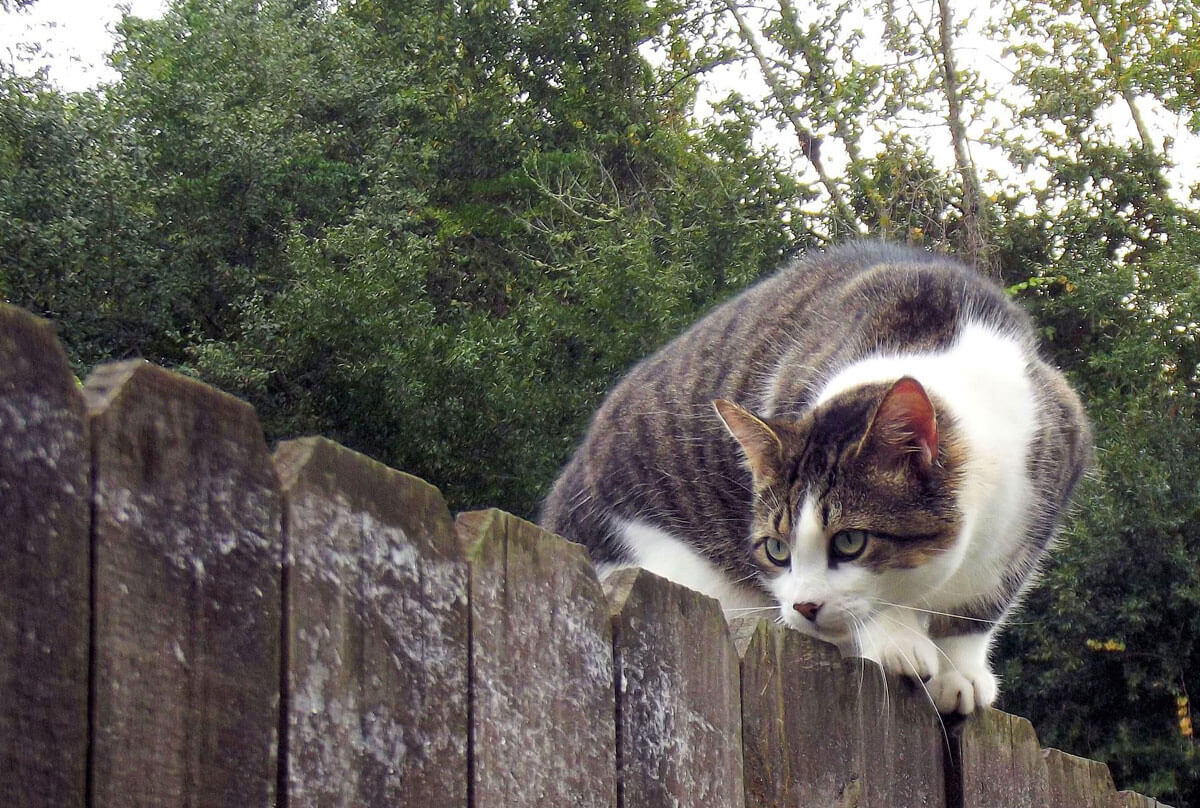
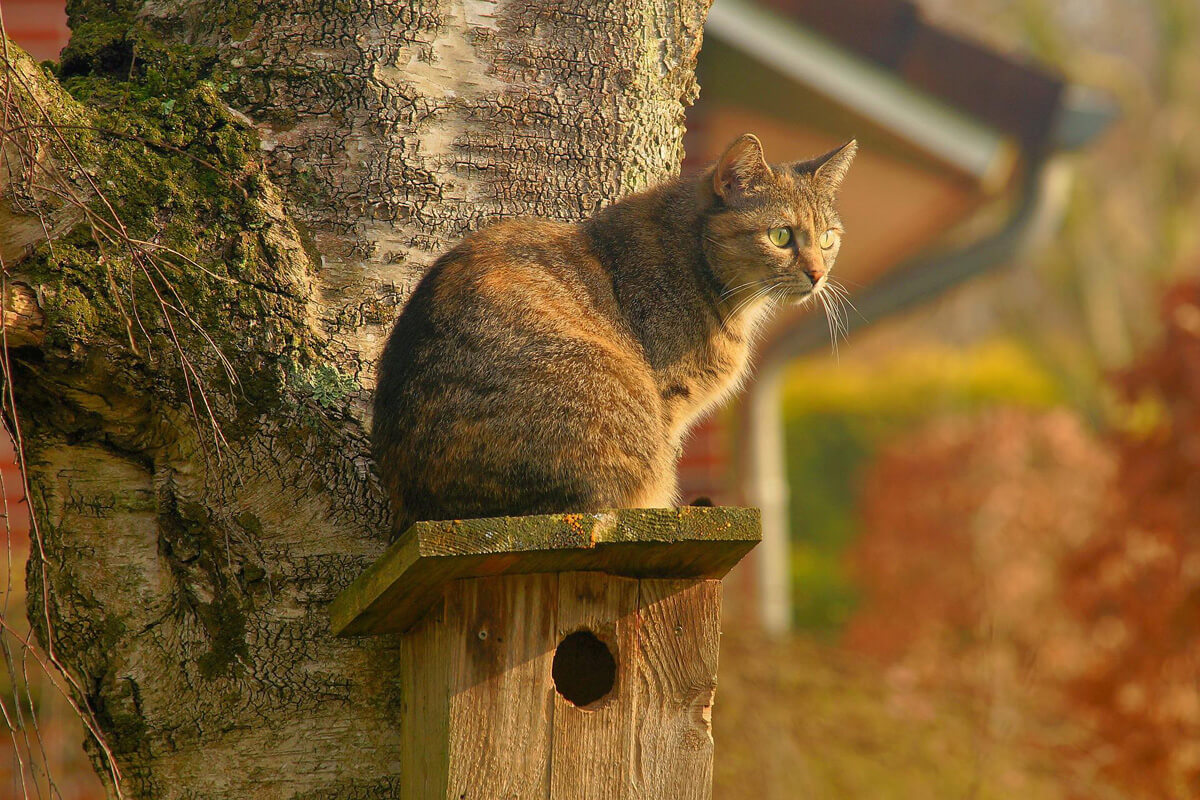
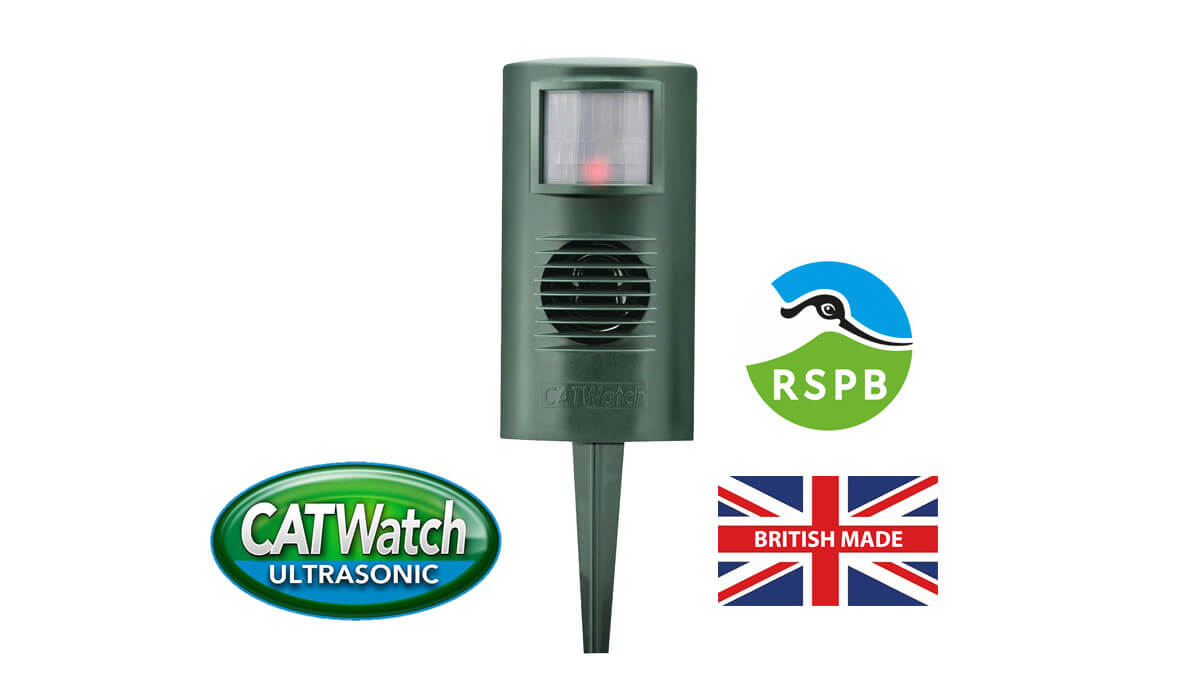
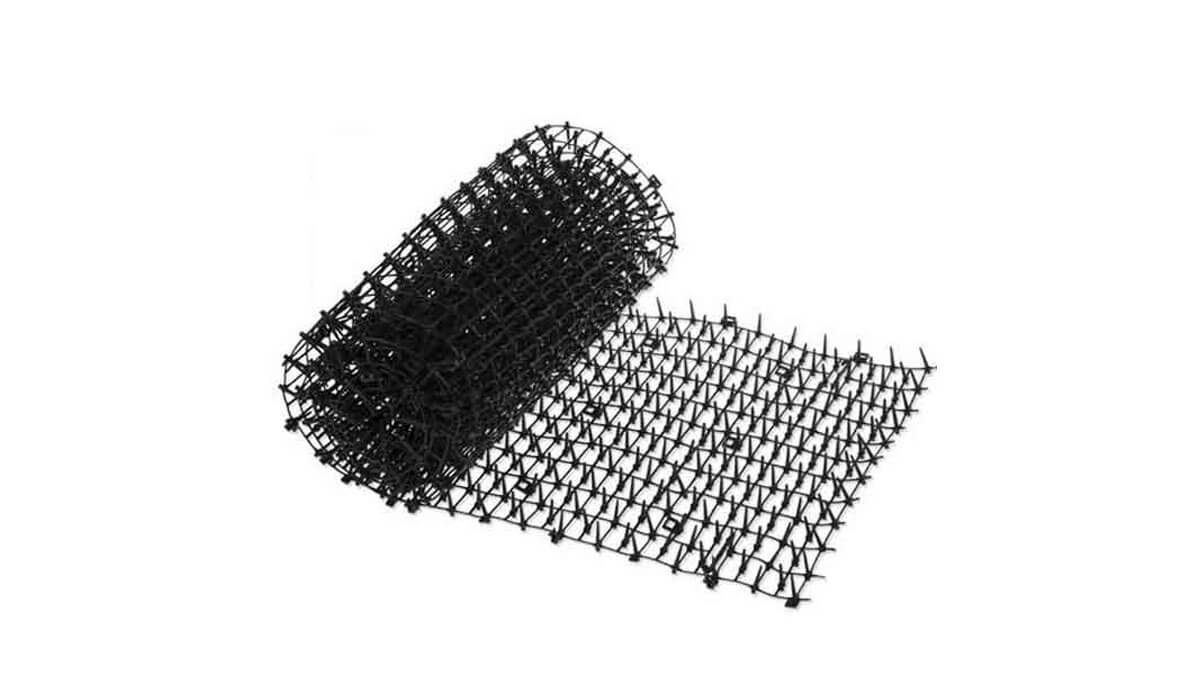
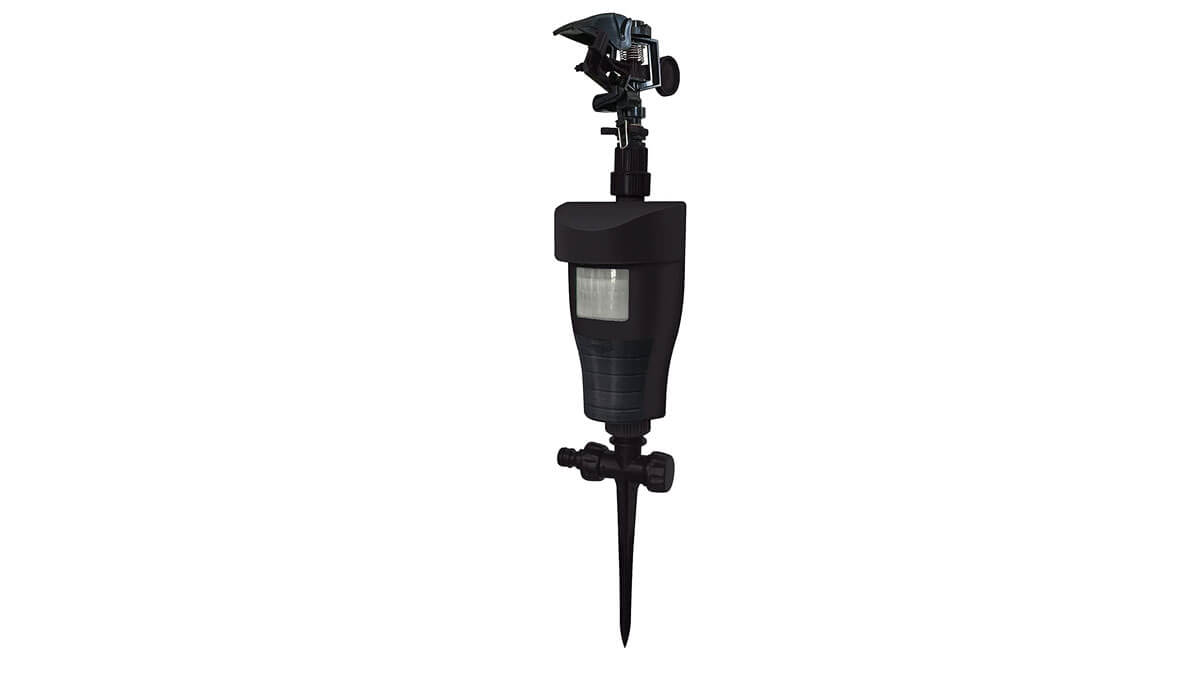

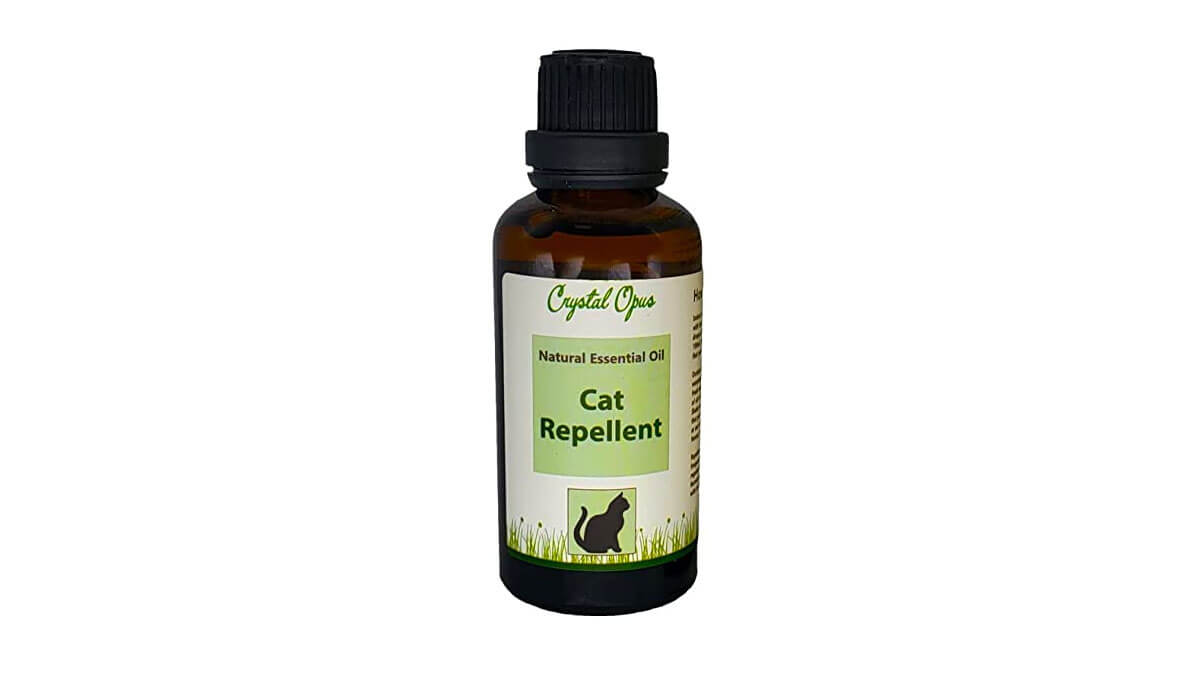

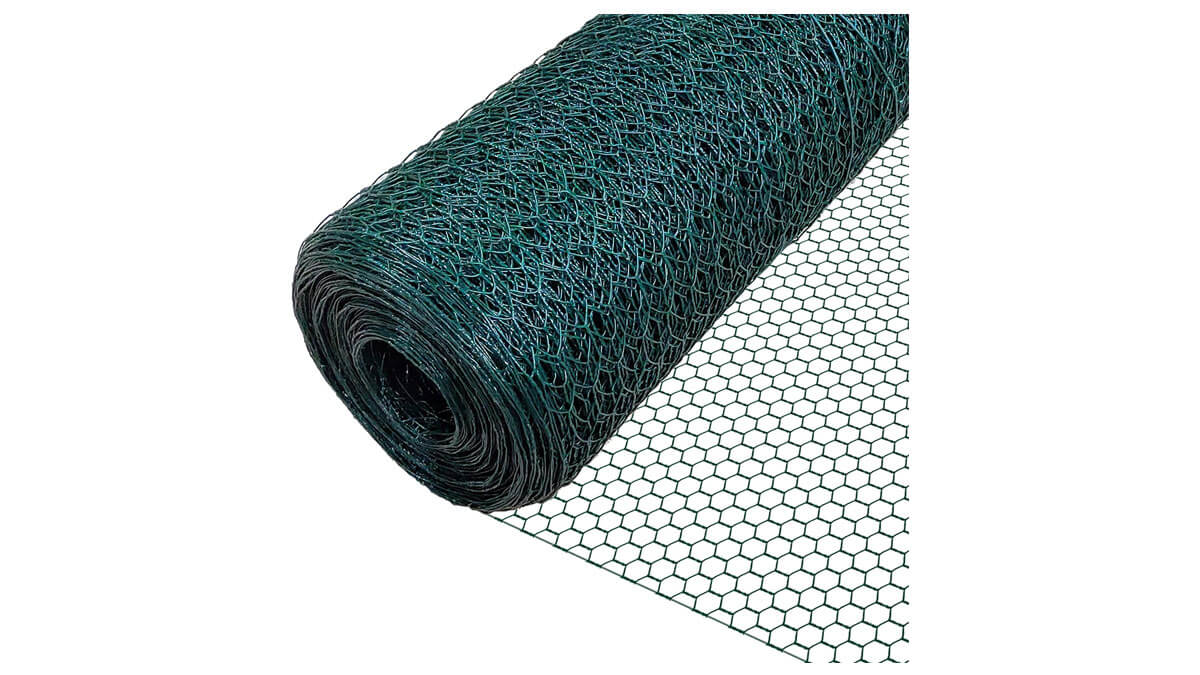



 Photo credit: Pixabay
Photo credit: Pixabay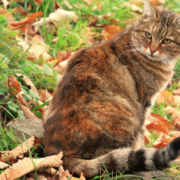 Photo credit: pasja1000 - Pixabay
Photo credit: pasja1000 - Pixabay